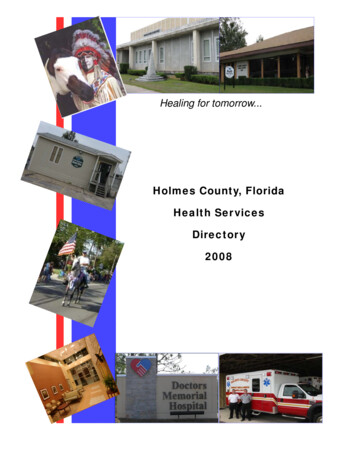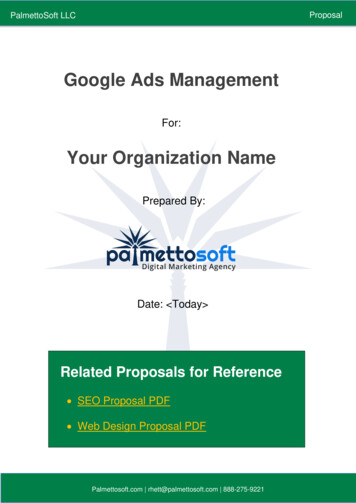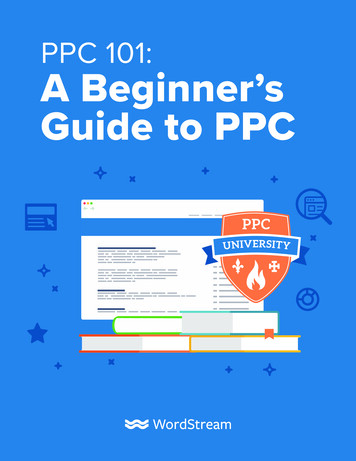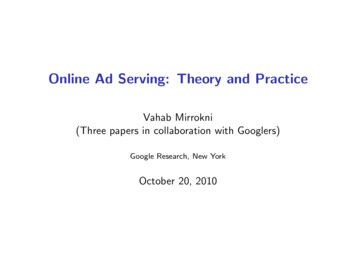
Transcription
ADS 547Property Management of InformationTechnology (IT)Full Revision Date: 11/20/2019Responsible Office: M/CIO/ITOFile Name: 547 112019
11/20/2019 Full RevisionFunctional Series 500 – Management ServicesADS 547 – Property Management of Information Technology (IT)POC for ADS 547: Zecharia (Zack) Kahn or (202) 916-4668, zkahn@usaid.govThis chapter has been revised in its entirety.Table of Contents547.1OVERVIEW . 4547.2PRIMARY RESPONSIBILITIES . 4547.3POLICY DIRECTIVES AND REQUIRED PROCEDURES . 6547.3.1Property Management of Information Technology (IT) . 6547.3.2547.3.2.1547.3.2.2Management of Information Technology Devices (One Device) . 7Reasonable Accommodation Request for an Additional Device . 7Business Waiver Request for an Additional Device . 7547.3.3547.3.3.1Procurement of IT Assets and Infrastructure . 8Local Purchasing of Information Technology Assets . 9547.3.4547.3.4.1547.3.4.2547.3.4.3Assignment of IT Assets . 9Assignment of IT Assets in USAID/W . 10Assignment of IT Assets in Missions. 10Emergency Distribution of IT Assets . 11547.3.5547.3.5.1Agency Hardware Inventory . 11Role of Bureau Property Custodians (AMS/EMT Officers) and MissionExecutive Officers (EXOs) in Inventory of IT Assets . 11Inventory of Agency IT Assets Used by Contractors in USAID/W andOverseas Locations . 13547.3.5.2547.3.6Safeguarding IT Assets . 14547.3.7IT Hoteling (Guest) Workstations . 16547.3.8Opening, Moving and Closing a Mission . 17547.3.9Secure Authentication Tokens (RSA Tokens) . 17547.3.10Leased or Loaned Commercial Property . 18547.3.11Receipt and Inspection of IT Assets . 18ADS Chapter 5472
11/20/2019 Full ration and Transfer Procedures for USAID/W and Missions . 19USAID/Washington Separation or Transfer Procedure . 19Mission Separation or Transfer Procedure . 19Institutional Contractors Separation or Transfer Procedure: Control ofInformation Technology (IT) Assets Provided as Government-FurnishedProperty (GFP). 20547.3.13Excess Capitalized Property . 21547.3.14Decommissioning Hardware and Software . 21547.3.15547.3.15.1547.3.15.2547.3.15.3Agency Software . 21Agency Software Inventory . 21Software Version Upgrade Requirements. 23Software Disposition . 24547.4MANDATORY REFERENCES . 25547.4.1External Mandatory References . 25547.4.2Internal Mandatory References . 25547.4.3Mandatory Forms . 26547.5ADDITIONAL HELP . 26547.6DEFINITIONS . 26ADS Chapter 5473
11/20/2019 Full RevisionADS 547 – Property Management of Information Technology (IT)547.1OVERVIEWEffective Date: 11/20/2019This chapter provides the framework for the worldwide property management ofUSAID’s information technology (IT) assets. This chapter applies to all Bureaus,Independent Offices, and Missions (B/IO/Ms), and organizations conducting businessfor, and on behalf of, USAID through contractual relationships when using USAID ITassets. Throughout this chapter, the terms "workforce" and “individuals” refer toindividuals working for, or on behalf of, the Agency, regardless of hiring or contractingmechanism, who have physical and/or logical access to USAID facilities and informationsystems. This includes, but is not limited to United States Direct-Hire employees,Personal Services Contractors, Fellows, Participating Agency Service Agreements, andContractor Personnel. Contractors are not normally subject to Agency policy andprocedures as discussed in ADS 501.1. However, contractor personnel are includedhere by virtue of the applicable clauses in the contract related to Homeland SecurityPresidential Directive 12 (HSPD-12) and information security requirements.IT assets include, but are not limited to: computers (government furnished equipment[GFE] laptops and desktops), software, voice over internet protocol (VoIP) phones (desklines), computer monitors, mobile phones, tablets, printers, scanners, fax machines,peripherals (e.g., computer memory, hard drives, keyboards, and cameras),infrastructure equipment (router, switch, hub, server, firewall, encrypter), tokens,portable storage devices (e.g., USB drives (M/CIO approved encrypted USB drives),and portable hard drives.Please note that some of the hyperlinks in the ADS can only be accessed on the USAIDnetwork (AIDNet).547.2PRIMARY RESPONSIBILITIESEffective Date: 11/20/2019a. The Bureau for Management, Office of the Chief Information Officer (M/CIO),is responsible for Information Resources Management (IRM), as defined in the EGovernment Act of 2002, OMB Circular A-130 and OMB M-16-02. M/CIO is alsoresponsible for all CIO functions that are mandated by the Clinger-Cohen Act of 1996,the Federal Information Technology Acquisitions Reform Act (FITARA) of 2014,and the Making Electronic Government Accountable By Yielding TangibleEfficiencies Act of 2016 (MEGABYTE Act). M/CIO designs, develops, issues, andimplements property management policies, guidelines, and programs that areapplicable to IT hardware and software.b. The Information Technology Property Management Officer (IT PMO): InUSAID/Washington (USAID/W), the CIO is the IT PMO. The M/CIO IT PMO isauthorized to delegate responsibility for the various other property managementADS Chapter 5474
11/20/2019 Full Revisionfunctions to other officers (preferably members of the same staff), such as theAccountable Property Officer (APO) and the Property Disposal Officer (PDO) (see ADS518, Personal Property Management (Domestic) and ADS 534, Personal PropertyManagement Overseas, for more information).The CIO IT PMO is responsible for budgetary reporting to the Office of Managementand Budget (OMB) and is responsible for accountability, receipt, storage, issuance,record keeping, inventory, reporting, and certification of all records and reports on ITassets within the Agency (see ADS 549, Telecommunications Management, ADS534, Personal Property Management Overseas, and 14 FAM 411.2-2a and 2-b).In overseas locations, the Executive Officer (EXO) or Agency Principal Officer (if noEXO is assigned) serves as the Mission IT Accountable Property Officer (APO) for ITassets, including leased IT assets. The EXO is responsible for all personal propertymanagement functions, including establishing internal policies and procedures formanagement and control of assigned personal property. The EXO is also responsiblefor maintaining an accurate inventory of IT assets and for providing that inventory to theM/CIO IT PMO to ensure that all USAID IT assets are accounted for. The EXO mustprovide M/CIO with support when IT asset information is required for data calls (e.g.,mobile phone usage (quantity of minutes, data and text messages)).Both the EXO and the CIO IT PMO must ensure that the policies and proceduresoutlined in this ADS chapter are implemented, and they must ensure compliance withAgency and government-wide authorities and guidelines (see ADS 549, ADS 534, and14 FAM 411.2-1).The Head of each Mission, Bureau, or Independent Office appoints anc.organizational Property Custodian, who is charged with ensuring that all IT assets,including, but not limited to, computer hardware, software, and cloud services used bythe organization are properly controlled in a manner aligned with M/CIO approvedsoftware (contact ecm@usaid.gov to determine if the proposed software is approvedfor use), IT Standards, and policies.d.USAID/W Property Custodians oversee IT assets assigned to personnel in theirorganizations. Administrative Management Staff/Executive Management Team(AMS/EMT) Officers, or the individual designated by the Head of each Bureau orIndependent Office, must ensure that all IT assets are assigned to an individual, andwhen not in use, are returned to M/CIO for storage, reassignment, or disposition (e.g.,Supervisory AMS Officers or AMS/EMT Officers).The Bureau for Management, Office of the Chief Information Officer, ITe.Operations Division (M/CIO/ITO) manages the maintenance of all Agency governmentfurnished equipment IT assets and IT infrastructure.The Agency workforce is responsible for the appropriate care, proper custody,f.and efficient use of IT assets issued for individual use.ADS Chapter 5475
11/20/2019 Full RevisionThe M/CIO Software Manager manages Agency-wide commercial andg.commercial off-the-shelf (COTS) software agreements and licenses. The SoftwareManager must develop and implement strategies to address life-cycle phases andreduce duplication of software licenses throughout the Agency by 1) centrally managingsoftware buys and reducing underutilization of software, 2) maintaining a continuousinventory of software licenses and tracking software usage, 3) consolidating redundantapplications, and 4) maximizing the use of best-in-class solutions.The Bureau for Management, Office of the Chief Financial Officer, Centralh.Accounting and Reporting Division (M/CFO/CAR) records and accounts forcapitalized asset(s), including IT capitalized software (see ADS 629.3.6).M/CFO/CAR maintains the general ledger accounts for capitalized property andoperating materials and supplies (see ADS 629.3.6), and issues a quarterly data call tothe B/IO/Ms requesting information on capitalized property, including IT property, andoperating material and supplies.The Bureau for Management, Office of Acquisition and Assistance (M/OAA) isi.responsible for working with Operational Units when acquisitions include IT and forensuring that the B/IO/M has secured M/CIO approval to move forward with theacquisition.j.B/IO/M Contracting Officer Representatives (CORs) furnish information on ITproperty required for the M/CFO capitalized data call. CORs must include the followingdata: Cost of capitalized software for any system put in use since the last reportingcycle; Useful life of capitalized software; Cost of expensed software; and Enhancement costs to software (both capitalized and expensed) (see ADS 629,Accounting for USAID-Owned Property and Internal Use Software for furtherguidance on capitalization for internal use software).547.3POLICY DIRECTIVES AND REQUIRED PROCEDURES547.3.1Property Management of Information Technology (IT)Effective Date: 11/20/2019The USAID workforce must ensure that government furnished IT, including commercialproperty leased or loaned to USAID, is used in accordance with the FITARA and theInformation Technology Management Reform Act (see Clinger-Cohen Act). The otherADS Chapter 5476
11/20/2019 Full RevisionFederal laws and regulations cited in this ADS chapter, along with the policies andprocedures detailed in this ADS chapter, are designed to ensure that IT assets aresafeguarded against waste, loss, and misuse.547.3.2Management of Information Technology Devices (One Device)Effective Date: 11/20/2019Per Executive Order (EO) 13589, each member of the USAID workforce is eligible tobe issued a single computer (a desktop or laptop) along with a minimum of a singlemonitor, relative to the employee’s responsibilities, a keyboard, PIV reader, mouse, anddocking station, if needed, and a desk phone. Assignment of mobile phones must beapproved by B/IO/M leadership (see ADS 549). Users that were issued two monitorsprior to September 30, 2019, are exempt from this requirement. For users with multiplemonitors, any replacements or purchases of new monitors after September 30, 2019,must be approved through a reasonable accommodation request or a business waiverrequest.B/IO Supervisory AMS Officers must contact the M/CIO Service Desk at (202) 712-1234or cio-helpdesk@usaid.gov to request assignment of an IT asset.Mission EXOs or System Managers must manage the assignment of the IT assets inMissions in accordance with M/CIO policy and in coordination with M/CIO.Note: On a case-by-case basis, M/CIO may re-evaluate a user’s business needrequirements when more than one device and/or multiple accessories were issued priorto the issuance of the policy in this ADS chapter.547.3.2.1Reasonable Accommodation Request for an Additional DeviceEffective Date: 11/20/2019Individuals with disabilities who require an additional or specialized device or computermonitor must submit a reasonable accommodation request to the USAID Office ofCivil Rights and Diversity Reasonable Accommodation Manager atreasonableaccommodations@usaid.gov (see ADS 111, Procedures for ProvidingReasonable Accommodation for Individuals with Disabilities). Procurement,operations, and maintenance support for the second device and/or associatedequipment must be approved and funded by the B/IO/M or through the M/MSmaintained centralized fund for reasonable accommodations. Approved reasonableaccommodation requests that support the assignment of a second device must besubmitted to the M/CIO Service Desk at (202) 712-1234 or cio-helpdesk@usaid.govby the requesting B/IO/M prior to procurement and installation for incorporation into theAgency IT inventory.547.3.2.2Business Waiver Request for an Additional DeviceEffective Date: 11/20/2019If members of the workforce do not meet the reasonable accommodation criteria above,ADS Chapter 5477
11/20/2019 Full Revisionbut still require an additional device or associated equipment in order to conduct Agencybusiness, they may request an additional device by submitting a business waiverrequest (https://www.usaid.gov/forms/aid-547-1). The additional device/associatedequipment must be approved by the individual’s supervisor, B/IO/M leadership (Directoror equivalent), and by M/CIO. Business waiver requests that are not related to areasonable accommodation requirement must include a detailed justification thatsupports the request, as well as a business case that documents the negativeoperational impact if the business waiver request is not approved. B/IO/M leadershipmust approve and submit the business waiver request to the M/CIO Service Desk at(202) 712-1234 or cio-helpdesk@usaid.gov. If approved, M/CIO will notify the B/IO/MAMS/EMT or EXO and provide a quote for the cost of the additional IT asset. TheB/IO/M must approve the cost and initiate an order through an M/CIO-approved blanketpurchase agreement (BPA). During the lifespan of the equipment, before it is disposedas outlined below, the additional IT asset (e.g., desktop, laptop, tablet, or mobile phone)and associated equipment must be maintained by the requesting B/IO/M; the requestingB/IO/M is responsible for funding all annual maintenance costs. Note: Additional ITassets in USAID/W will be returned to the Agency inventory for reassignment when nolonger in use by the designated user. The additional IT assets in a Mission will bereturned to the Mission replacement inventory for reassignment when no longer in useby the designated user.547.3.3Procurement of IT Assets and InfrastructureEffective Date: 11/20/2019B/IO/Ms are prohibited from purchasing any equipment that is not through an M/CIOapproved means for use on the Agency network. B/IO/Ms should contact M/CIO if theequipment required by the B/IO/M is not available on the Agency approved BPA forguidance on alternate purchasing options.Effective in Fiscal Year (FY) 2018, B/IO/Ms must no longer purchase their own laptopsand desktops. M/CIO centrally manages all purchasing of laptops and desktops.M/CIO works with B/IO/Ms to develop an annual IT refresh plan for their organization forlaptops and desktops.B/IO/Ms must only procure IT infrastructure equipment (e.g., servers, routers, switches,network printers) that are currently approved for purchase by M/CIO (see IT Standards)and are available for purchase through a M/CIO Blanket Purchase Agreement (BPA)(please contact your B/IO/M Contracting Officer for guidance on methods ofprocurement). If the equipment is not on the IT Standards list, then the B/IO/M mustobtain M/CIO approval prior to procurement. The B/IO/M must request this approval bysubmitting a software and hardware approval request (SHARP). B/IO/Ms areprohibited from purchasing IT infrastructure equipment that is not approved by M/CIO.Missions must work with M/CIO to develop and maintain an adequate replacementinventory for any IT assets including IT infrastructure equipment to ensure thatdamaged or lost/stolen equipment can be replaced in a timely manner. Missions mustADS Chapter 5478
11/20/2019 Full Revisionupdate their IT inventory as IT assets are replaced. Missions must also alert M/CIOwhen inventory IT infrastructure equipment is put in service to ensure that replacementsare ordered in a timely manner.In instances where B/IO/Ms have procured unapproved IT infrastructure equipment,they must not install the equipment on devices connected to AIDNET. M/CIO will notconfigure unapproved infrastructure equipment, will not provide technical support, andin most instances will require the B/IO/M to return or dispose of the unapprovedequipment.547.3.3.1Local Purchasing of Information Technology AssetsEffective Date: 11/20/2019In accordance with OMB A-130, Executive Order on Securing the Information andCommunications Technology and Services Supply Chain, and National Institute ofStandards and Technology Special Publication (NIST SP) 800-161, Supply Chain RiskManagement Practices for Federal Information Systems and Organizations, IT assetsmust not be procured locally or in-country. All IT assets must be purchased in theUnited States and through M/CIO supported acquisition vehicles where possible.M/CIO will maintain a Blanket Purchase Agreement (BPA) for procuring all approved ITassets.USAID’s approved IT asset BPA, centralized procurement, and U.S.-purchased IT assetacquisitions helps the Agency meet government-wide standards and requirements, andmitigates supply chain risks associated with information and communicationstechnology (ICT) products and services. Among other benefits, these acquisitionsprevent the purchase of counterfeit equipment and protect the network from malicioussoftware and hardware.547.3.4Assignment of IT AssetsEffective Date: 11/20/2019All IT assets must be assigned to an individual user who takes physical possession andaccountability of the device.In addition, all IT assets must have a U.S. Direct-Hire, or designee, that acceptsownership of IT assets on behalf of their B/IO. By taking ownership, the Direct-Hire isresponsible for managing the IT asset inventory. The Direct-Hire is responsible forreporting lost, damaged, or stolen equipment to M/CIO. In the event ofunexplained/unresolved discrepancies, it is the responsibility of the Direct-Hire toresolve such problems. B/IOs are financially responsible for replacement of lost,damaged, or stolen endpoint devices (see 547.3.6 for guidance on individualresponsibility for safeguarding IT assets).In the continental United States (CONUS), the Supervisory AMS Officer is the U.S.Direct-Hire responsible for IT endpoint, shared, and infrastructure devices in the B/IO.ADS Chapter 5479
11/20/2019 Full RevisionOutside the continental United States (OCONUS), the EXO or a designated USPSC isresponsible for IT endpoint, shared, and infrastructure devices.IT assets that are shared and considered “community” assets, such asprinters/scanners or devices in conference rooms or desktops or laptops designated for“hoteling” offices/cubicles are the responsibility of the USAID/W Property Custodian orthe Mission EXO or System Manager.The B/IO/M AMS/EMT Officers or EXOs, or the designated USPSC, must ensure thatall IT assets issued to their organizations are accounted for in the Agency IT inventory(see 547.3.5 for additional guidance). In instances where B/IO/M AMS/EMT Officers orEXOs are unable to locate an IT asset, they must immediately notify M/CIO that theequipment is missing (see 547.3.6 for further guidance).Effective FY 2019, all OE-funded IT assets not in use will be stored or reassigned basedon Agency needs.547.3.4.1Assignment of IT Assets in USAID/WEffective Date: 11/20/2019B/IOs must request assignment of end point devices (e.g., desktop computers, laptops,workstations, smartphones, tablets, and servers) and accessories by submitting arequest to the M/CIO Service Desk at (202) 712-1234 or cio-helpdesk@usaid.gov. InUSAID/W, endpoint devices and accessories must only be requested when they can beassigned to an individual and that individual has an assigned Bureau for Management,Office of Management Services Headquarters Management Division (M/MS/HMD)approved/authorized desk space (see Space Management for additional guidance) oris officially approved to work offsite. Government Furnished Equipment (GFE) will beissued to members of the workforce who work remotely upon request from the B/IO.Starting in FY 2019, M/CIO will implement an IT refresh plan for the Agency. B/IOsmust provide M/CIO with an annual needs analysis to update the annual IT refresh planno later than January 30 of each year through an annual data call.If M/CIO has refreshed or scheduled a refresh of endpoint devices for your B/IO, theprocurement of an additional device (outside of the one device policy) will require that aBusiness Waiver or 508 Compliance Waiver request be submitted and approved. Thepurchasing B/IO will be responsible for purchase and ongoing Operations andManagement (O&M) costs.547.3.4.2Assignment of IT Assets in MissionsEffective Date: 11/20/2019Missions must work with M/CIO to ensure that new IT assets are issued andincorporated into the authoritative IT Asset Management System (ITAM) for the correctusers and that excess assets are removed from the network and disposed of inADS Chapter 54710
11/20/2019 Full Revisioncompliance with the M/CIO IT disposal process.547.3.4.3Emergency Distribution of IT AssetsEffective Date: 11/20/2019Emergencies come in many forms (e.g., hurricanes, tornadoes, earthquakes, floods,epidemics, terrorist attacks, etc.) that may displace USAID individuals. In the limitedcircumstance of an emergency that requires individuals to be relocated to an alternatelocation, M/CIO may assign IT assets to the relocated individuals. Requests for suchassignments may come from an approved authority (AMS, EXO/System Manager (SM),etc.).For OCONUS, Missions that have excess equipment available may make thisequipment available to the affected Mission. When loaning equipment, Missions mustupdate the ITAM for asset tracking purposes.547.3.5Agency Hardware InventoryEffective Date: 11/20/2019M/CIO is responsible for maintaining an up-to-date Agency-wide inventory of IT assetspurchased by USAID, which includes IT assets purchased by USAID B/IO/Ms. M/CIOmust barcode all accountable hardware purchased by USAID/W B/IOs and record thebarcodes in the ITAM. If a Mission receives any IT assets without barcodes, the EXOmust contact the M/CIO Service Desk at (202) 712-1234 or cio-helpdesk@usaid.govto request barcodes, and ensure that the M/CIO approved barcode is affixed to theasset and the details are reported to M/CIO for inclusion in the ITAM System.B/IO/Ms and users are prohibited from removing M/CIO-issued barcodes from ITassets.To ensure that the Agency’s IT asset inventory is up-to-date, M/CIO will conduct anannual, full physical inventory for CONUS sites, and will coordinate the OCONUSinventory by working with Missions to complete and certify their physical inventory.547.3.5.1Role of Bureau Property Custodians (AMS/EMT Officers) and MissionExecutive Officers (EXOs) in Inventory of IT AssetsEffective Date: 11/20/2019M/CIO, in coordination with Property Custodians (e.g., AMS/EMT Officers) in USAID/Wand EXOs and System Managers (SMs) overseas, are the personnel responsible forconducting the annual physical inventory of IT assets to ensure the accuracy of ITresource records.Physical inventory: For USAID/W, M/CIO conducts a physical inventory of all CONUSIT assets and compares it to IT assets listed in the ITAM system. For overseaslocations, EXOs or the Mission Systems Manager are required to conduct an annual ITasset inventory and submit the list to M/CIO for comparison to the ITAM system. TheADS Chapter 54711
11/20/2019 Full RevisionAMS/EMT and/or EXO/SM must note any inconsistencies in ITAM. M/CIO will updatethe ITAM system accordingly, and report any lost or unaccounted for assets to M/CFOand the United States Computer Readiness Team (US CERT).It is the B/IO/M’s responsibility to ensure IT assets assigned to their organization areproperly tracked. AMS/EMT Officers, EXOs/SMs, or individual staff may contact theM/CIO Service Desk at (202) 712-1234 or cio-helpdesk@usaid.gov to request an ITasset report. Individual staff not responsible for organizational IT assets may onlyrequest reports for IT assets that are assigned to them. See 547.3.6, for guidance onmissing or unaccounted for IT assets. AMS/EMT Officers in USAID/W and MissionEXOs must certify the results of the annual inventory.In coordination with the M/CIO Asset Management Group, EXOs must conduct an ITasset inventory as follows: Certify IT Asset Inventory: EXO’s must certify annually that they have reviewedthe most recent Mission IT asset inventory. Annual full physical inventory: The EXO/SM must report the results to the M/CIOAsset Management Group via the M/CIO Service Desk at (202) 712-1234 or ciohelpdesk@usaid.gov by submitting a formal certification letter that lists all of theIT assets and includes a detailed description of all relevant information (barcodesand the individual assignee (see 547.3.3) of the IT assets must be included). The EXO/SM must update the inventory of IT assets when a member of theMission workforce joins or departs the Mission by updating the ITAM orcontacting the M/CIO Asset Management Group via the M/CIO Service Desk at(202) 712-1234 or cio-helpdesk@usaid.gov to record the change.Missions are required to participate in the USAID Asset Inventory, regardless of theiruse of the International Cooperative Administrative Support Services (ICASS) orIntegrated Logistics Management System (ILMS).See 547.3.3, Procurement of IT Infrastructure and 547.3.4, Assignment of ITAssets for guidance on procurement and assignment of IT assets to individual users.See 547.3.6, Safeguarding IT Assets for guidance on reporting lost or stolen ITassets. See 547.3.16, Agency Software for guidance on requirements related tosoftware.If equipment is determined to be surplus, M/CIO must prepare a report for the file, andinclude a full explanation of the known circumstances as well as a statement that thesurplus is the result of the physical inventory. M/CIO must adjust the inventoryaccordingly and notify the Bureau for Management, Office of the Chief Financial Officer(M/CFO) of any situation affecting capitalized property (see ADS 629, Accounting forUSAID-Owned Property and Internal Use Software).ADS Chapter 54712
11/20/2019 Full Revision547.3.5.2Inventory of Agency IT Assets Used by Contractors in USAID/W andOverseas LocationsEffective Date: 11/20/2019a. Contractors are required to maintain records for government property, includingIT assets, in accordance with the terms and conditions of their contract.Government property includes government furnished property (GFP) and mayinclude contractor acquired property (see ADS 306mah and ADS 302for additional policy and procedures and COR responsibilities regardinggovernment property).This section applies to both Operating Expense (OE)-funded and programfunded contracts, if either or both of the following conditions are met: The title of the IT assets reverts to the Agency at the end of the contract,or The title remains with the Agency.b. B/IO/M’s and local system managers may request that M/CIO issue Agency ITassets to contractors as GFP. USAID contractors may be held liable for anyAgency IT asset lost or damaged by their employees. M/CIO will perform ayearly physical inventory of IT assets located in USAID/W, including assetsassigned to contractors. Missions are required to provide their IT assetinventory, including assets assigned to contractors, to the M/CIO AccountableProperty Officer. Only IT assets that are published on the M/CIO IT Standardswebsite and procured through M/CIO are authorized for use on AIDNet. An
implements property management policies, guidelines, and programs that are applicable to IT hardware and software. b. . Mission EXOs or System Managers must manage the assignment of the IT assets in Missions in accordance with M/CIO policy and in coordination with M/CIO. Note: On a case-by-case basis, M/CIO may re-evaluate a user's business .











